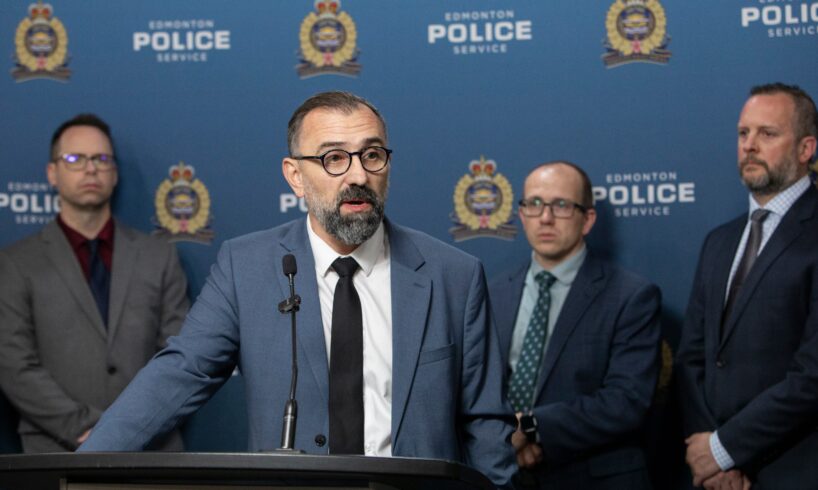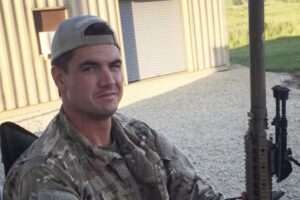
Open this photo in gallery:
Homicide Detective Jared Buhler, the lead investigator into the Samuel Bird case, speaks during a press conference in Edmonton on Friday.Amber Bracken/The Globe and Mail
It was 4 a.m. on Thursday morning, under a waning crescent moon, when police found the remains of 14-year-old Samuel Bird within a stand of trees off a farmer’s field, west of Edmonton.
“It’s a moment I’ll remember forever,” the case’s lead investigator, Homicide Detective Jared Buhler, told reporters, describing the scene in detail at a news conference on Friday afternoon. He noted that Samuel’s spiritual name is Little Boy on the Moon.
“I believe everything happens for a reason,” Det. Buhler said. “It’s hard not to believe that we were meant to find Samuel on that day, at that time.”
It was exactly four months to the day after homicide investigators had taken over the case, and one day after a tactical team arrested 38-year-old Bryan Clinton James Farrell and charged him with second-degree murder in Samuel’s death.
Open this photo in gallery:
Samuel Bird was last seen in West Edmonton on June 1. Police believe he was killed that night.SUPPLIED/CANADIAN PRESS
Mr. Farrell is facing a raft of other charges related to the investigation, including for allegedly burning down his own home, and threatening to harm or kill Samuel Bird’s mother, Alanna Bird – both in recent weeks.
The news conference provided new details about a case that has captured the attention of people around Alberta and far beyond, offering a glimpse into an intensive police investigation conducted so deeply out of public view that many people believed police weren’t investigating at all.
“We found Sam and we charged somebody for Sam’s murder. Behind the scenes, people don’t understand how difficult that is, the evidence we need to, A) locate the body and B) then sustain the charge in court,” said Det. Buhler, who stood flanked by other homicide investigators who worked on the case, the homicide section staff sergeant, and Police Chief Warren Driechel.
“There have been so many times in this case where our investigation has hung by a literal thread. And the pressure of knowing that we can fail at any moment, including three o’clock on yesterday morning, I can’t even describe that,” Det. Buhler said.
Police Chief Driechel acknowledged that there have been “questions and speculation” around the timeline of when information about the case was made public.
“I hope this investigation illustrates how seriously we take missing persons, and not all police work is done in the public eye,” he said. “Our major crimes branch was investigating this long before the first news release was issued, and as Detective Buhler has previously stated, every step that was taken in this investigation was done strategically.”
Open this photo in gallery:
Det. Buhler, left, hugs Samuel Bird’s grandmother Geri Potts as police search for the 14-year-old’s remains.Amber Bracken/The Globe and Mail
The investigation into Samuel’s death was named Project Hobbledehoy, which he described as “a term which has been used to describe a boy in the awkward stage between childhood and adulthood.”
Samuel was last seen on surveillance video walking through a schoolyard on his way to Mr. Farrell’s residence in West Edmonton on June 1. Police believe he was killed that night, and his body taken out of the city and hidden within the next day.
Ms. Bird reported Samuel missing to police on June 6, and homicide investigators took over the case 10 days later. Ms. Bird previously told The Globe and Mail that Samuel had been dating Mr. Farrell’s daughter.
Police did not publicly announce that Samuel was missing for more than a month, and did not confirm his disappearance was considered suspicious until late in August. At the same time, Samuel’s parents and their families embarked on their own community searches, sparking an active movement both online and in real life, fuelled both by a concern for the Indigenous teen, and by a narrative that police weren’t investigating or searching for Samuel.
Samuel’s parents have expressed their gratitude to investigators and have said they trusted the investigative strategy.
Det. Buhler said the investigation benefitted from the perception that police weren’t doing anything, but he noted that the cost of the investigative strategy was “withering public criticism,” which ranged from “political comment to daily denigration on social media,” and personal criticism.
“While there have been positive aspects to the public and social media attention Samuel’s case has drawn, there has also been an element I would characterize as social vigilantism,” he said. “At several stages, this directly impacted and jeopardized the police investigation.”
But despite serious challenges that included misinformation, rumours and floods of repeated, discounted or baseless tips, Det. Buhler said police now have a “near-complete understanding of the circumstances of Samuel’s disappearance and death,” including being able to say that videos and images circulating online that purported to show the homicide are “categorically false.”
He said the investigation has also determined that other youths and members of Mr. Farrell’s family were not involved in the homicide, and that “the continued doxing of any youth associated to this investigation is morally and legally inappropriate.”
“While our investigation will continue, this case is now before the court where it will be tried,” he said. “Investigations are not conducted on social media, nor should they be tried there.”
Mr. Farrell is slated to make his first court appearance on Monday.





